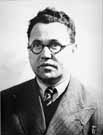
|
|
|

|

|

|

|
|
Click on an image to see a larger, more detailed picture.
|
|
|
|
|
| 1941: Mass Murder |

|
pg. 282 |

|
|
|
|
| |
 At Theresienstadt in Occupied Czechoslovakia, the Nazis established a "model" ghetto and concentration camp. This photograph shows the arrival of Jews in the camp. Theresienstadt became infamous as Europe's largest children's camp. All but a few hundred of the thousands of children interned there died. Nevertheless, the Nazis cynically exhibited the camp to the outside world, insisting that the inmates were treated well.
At Theresienstadt in Occupied Czechoslovakia, the Nazis established a "model" ghetto and concentration camp. This photograph shows the arrival of Jews in the camp. Theresienstadt became infamous as Europe's largest children's camp. All but a few hundred of the thousands of children interned there died. Nevertheless, the Nazis cynically exhibited the camp to the outside world, insisting that the inmates were treated well.
Photo: Lydia Chagoll / United States Holocaust Memorial Museum Photo Archive
|
 Jacob Edelstein was among the leading figures in Czechoslovakia's Zionist movement before the start of the war. He became the first chairman of the Theresienstadt Ghetto's Jewish Council. He used this position to resist efforts to deport the ghetto's Jews. Bravely, he falsified daily reports concerning the number of Jews in the ghetto. The Nazis deported him in December 1943 to Auschwitz, where he and his family were shot on June 20, 1944.
Jacob Edelstein was among the leading figures in Czechoslovakia's Zionist movement before the start of the war. He became the first chairman of the Theresienstadt Ghetto's Jewish Council. He used this position to resist efforts to deport the ghetto's Jews. Bravely, he falsified daily reports concerning the number of Jews in the ghetto. The Nazis deported him in December 1943 to Auschwitz, where he and his family were shot on June 20, 1944.
Photo: Terezin Museum / United States Holocaust Memorial Museum Photo Archive
|
 Theresienstadt
Theresienstadt
On June 4, 1942, Pavel Friedmann, 21, finished a poem about the last butterfly he ever saw. "Butterflies," the Jewish writer concluded, "don't live in here, in the ghetto." A few weeks earlier, the Germans had deported Friedmann to Terezín, Czechoslovakia (Theresienstadt in German), the walled military town where they began to ghettoize Czech Jews in the autumn of 1941. A year later 50,000 Jews were struggling to survive in Theresienstadt's deteriorating conditions. Theresienstadt also became a concentration and transit camp for German and Western European Jews who were eventually deported to Auschwitz. In mid-1944 the Nazis temporarily beautified Theresienstadt to deceive an investigating committee from the International Red Cross and to make a propaganda film that pictured the ghetto as Hitler's gift to the Jews. The facts were very different. Of the over 140,000 Jews who were sent to Theresienstadt, 33,000 died and 88,000 were deported and killed. Only about 19,000 survived. Pictured is a standard identity card. Despite starvation, overcrowding, disease, and the constant dread of transports to the East, the Jewish leadership of Rabbi Leo Baeck and others emphasized educational and cultural activities. Friedmann died in Auschwitz on September 29, 1944, but his poem, "I Never Saw Another Butterfly," exemplifies the artistic expressions from Theresienstadt, which are among the most precious documents recovered from the Holocaust.
Photo: Frihedsmuseet/United States Holocaust Memorial Museum Photo Archive
|
|

|

|

|

|
 November 27, 1941: The first of 19 deportation trains leaves Germany for Riga, Latvia. In the Riga Ghetto, more than 10,600 Jews are rounded up and shot in the nearby Rumbula Forest.
November 27, 1941: The first of 19 deportation trains leaves Germany for Riga, Latvia. In the Riga Ghetto, more than 10,600 Jews are rounded up and shot in the nearby Rumbula Forest.
|
 November 28, 1941: Hitler entertains Hajj Amin al-Husseini. The grand mufti of Jerusalem pledges to cooperate in the extermination of the Jews and offers to enlist Arabs to fight for Germany.
November 28, 1941: Hitler entertains Hajj Amin al-Husseini. The grand mufti of Jerusalem pledges to cooperate in the extermination of the Jews and offers to enlist Arabs to fight for Germany.
|
|
|
|
|
| 1941: Mass Murder |

|
pg. 282 |

|
|
The Holocaust Chronicle
© 2009 Publications International, Ltd.
|
|
